Quick search
CTRL+K
Quick search
CTRL+K

Dresden is one of the most beautiful cities in Germany. Zwinger, Katolische Hofkirche, Semperoper and Frauenkirche are some of the famous building from the magnificent baroque era, which the city is so famous for. However, Dresden has much more to offer as well, such as Altmarkt and Prager Straße, both originating from the GDR.
Throughout time, the Saxon princes have built Dresden as a true world city in beautiful Baroque, and fine culture has always flourished among the beautiful buildings. As a visitor, you will enjoy this when you visit the grand museums, see the fine architecture or just walk the city streets. The scenery along the River Elbe is worth seeing on the way.
Dresden was almost totally wiped out by a Allied bombing 13-15 February 1945, but since then the city has resurrected to former glory. It happened with almost the same ambition as in the original constructions. The history of the bombing and reconstruction can be seen in museums, and the church of Frauenkirche is the landmark building of this part of Dresden’s history.
In addition to Dresden’s own beauty, the city is located in the middle of a beautiful area where there is never far to the next fine city and stunning piece of nature. Highlights include the porcelain city of Meissen, the castles of Pillnitz and Königstein, as well as the Saxon Switzerland National Park.
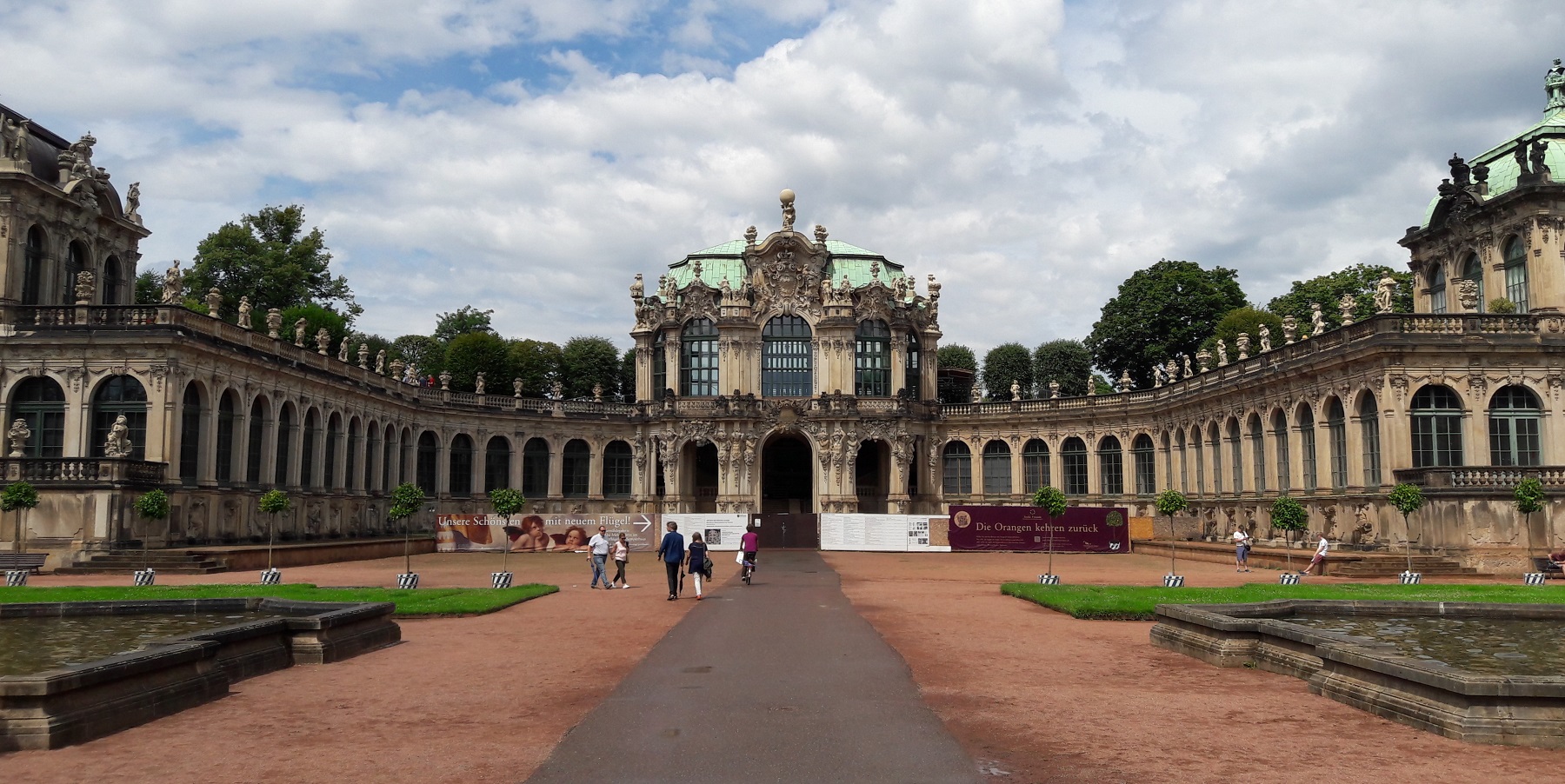
The orangery, garden and palace Zwinger is one of Dresden’s most famous buildings, and it stands as one of the city’s landmarks. The Zwinger was designed by the architect Matthäus Daniel Pöppelmann and is located in the inner city. The Zwinger is one of the major facilities in the historic center of Dresden.
The Zwinger was built in late baroque in the years 1710-1728 with various additions up to 1855, and it is considered one of Europe’s finest buildings in the 18th century style of this time. The facility is very harmonious with its strict symmetry and beautiful baroque courtyard. Elector Friedrich August I was said to have been inspired by the open space of the Roman Forum in Rome.
The name Zwinger comes from a designation for the area between two fortifications. This was the case in Dresden, where the first city walls were built in the 12th century with later 15th century walls at a greater distance from the city centre. Between the walls was a moat, which was gradually filled up, and thus the Zwinger area arose.
In the years 1687-1689, August I had been traveling in France, where he had seen Versailles. Later, among other things, he was crowned king of Poland, and he wanted to emphasize his status with a large palace-style orangery with gardens. The old rampart area was good for the purpose, as it could accommodate both a beautiful new palace and a park. The park could spread down to the banks of the Elbe, and it was only later that the now historic part of the castle park was built.
The Zwinger came to consist of several buildings. Towards the northeast and the Theaterplatz is the Gemäldegalerie Alte Meister art museum in the Sempergalerie building, which was built precisely as an art museum by Gottfried Semper in the years 1847-1855. The exhibition shows particularly fine European art from, among other things, Germany, the Netherlands and Italy. The Sempergalerie was built later than the rest of the Zwinger, as this part had not been prioritized after August I’s death in 1733.
The southern entrance from the city is via the Klokkespilpavillonen/Glockenspielpavillon, named after the 40 Meissen porcelain bells that were hung here in 1936. The pavilion houses the Porcelænssamlingen/Porzellansammlung museum, which is the finest of its kind in the world. Here you can see, among other things, Meissen porcelain, but also other productions and previous production techniques.
To the west lies the moat Zwingergraben, which is a remaining part of the historic ramparts. The Moat Bridge/Wallgrabenbrücke leads over the moat to the Kroneporten/Kronentor entrance, clearly recognizable by the roof, which is adorned with a large crown. On either side of Kronentor are the Langgalerie galleries.
In the north-western part of the complex towards Zwinger’s park is the beautiful Wallpavillon from 1716, which has a statue of Hercules on top, carrying the globe on his shoulders. Wallpavillon serves as the entrance to the Zwingergarten park, which as an open park with lawns is suitable for a promenade. Between the Wallpavillon and the Sempergalerie is the French Pavilion/Französischer Pavillon, and behind it you can see the pool and the Nymphenbad fountain with many artfully executed figures.
To the northwest of the facility you can visit one of the Zwinger’s museums. It is the Mathematical-Physical Salon/ Mathematisch-Physikalischer Salon, where science is at the fore. Old instruments and effects such as a planet clock from the Renaissance are among the objects on display.
Like so much else in Dresden, the Zwinger was razed to the ground by the Allied bombardment that took place on the 13th-15th. February 1945. A reconstruction started already that year with support from the Soviet Union, and the first part of the rebuilt facility was opened in 1951.
The magnificent Semper Opera was performed in the years 1838-1841 as the Saxon Court Theatre, and thus the stage was Saxony’s state opera. The architect was Gottfried Semper, and he is the only architect in Germany to have his theater named after him. The building burned down in 1869, but was rebuilt by Semper’s son in the years 1871-1878.
The opera was not the first in Dresden. At the Zwinger was another opera house, which was active from 1719 to 1849, and the Semperoper thus came to continue this part of the city’s theater traditions.
The Semperoper was completely destroyed during the bombing in February 1945, but it was rebuilt and opened a few years after World War II in its former glory. The interior of the Semperopera is very beautiful, and you get a lot out of seeing it on a tour, but it is of course a special experience to witness a production here.
The repertoire today is opera, but you can also see ballet, dance and concerts. From early times, Gottfried Semper’s opera house has been a popular stage and there have been many premieres here; for example by Richard Wagner’s Tannhäuser und der Sängerkrieg auf Wartburg.
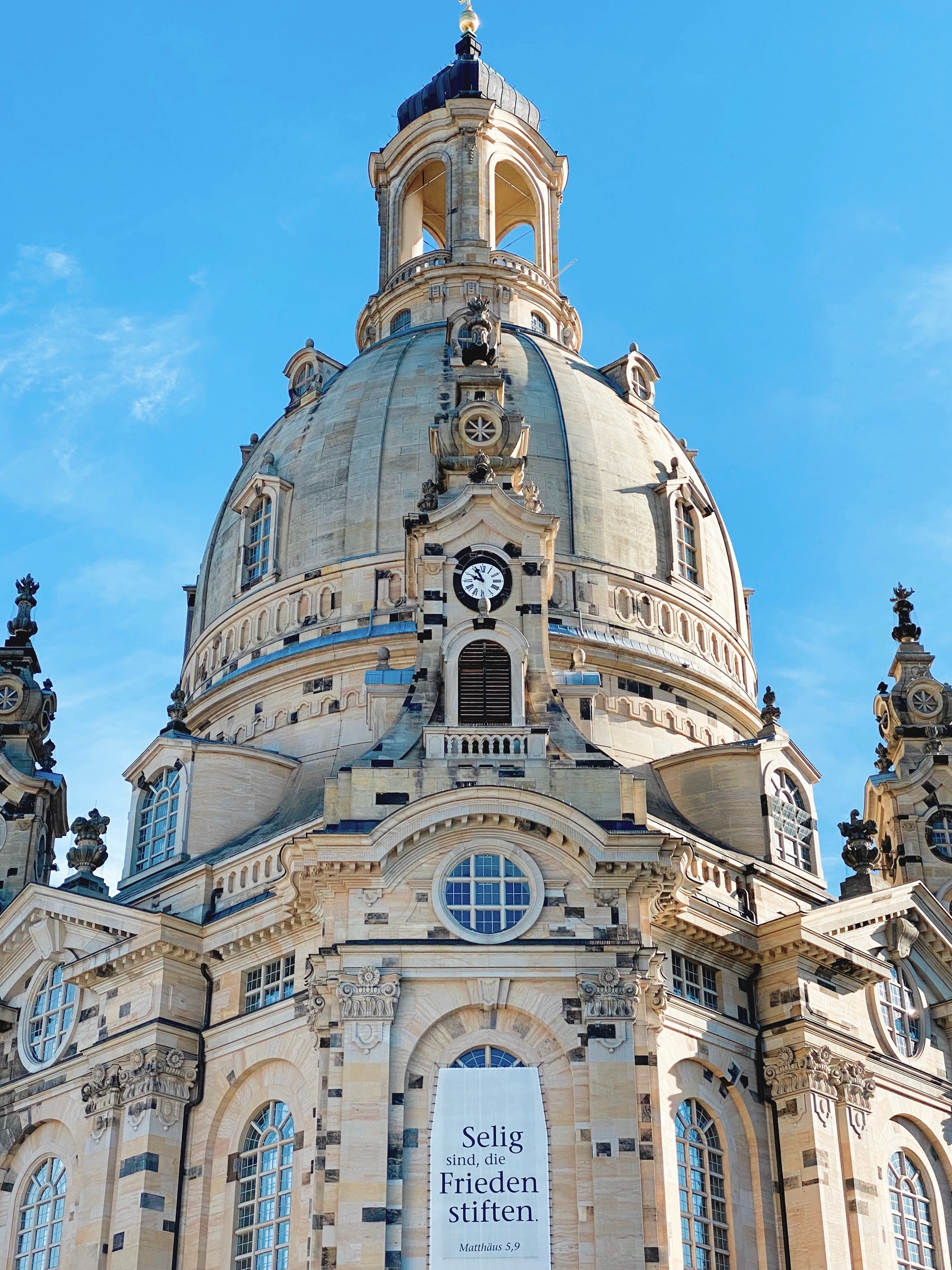
Dresden’s Church of Our Lady/Frauenkirche has throughout history been one of Germany’s most important Protestant churches, and for many it is the symbol of the rebuilding of Dresden after the Allied bombs in February 1945. The rebuilt Frauenkirche is today one of the city’s landmarks.
There has been a church here long before the current Frauenkirche, which was built 1726-1743 according to George Bähr’s drawings. The first church was a Romanesque building from the 11th century, and it stood until the current church was built as a larger and more beautiful replacement, befitting the town’s status as a residence.
Bähr’s design of the Frauenkirche was groundbreaking for Protestant churches with its interior design. The central liturgical parts such as the altar and baptismal font were placed centrally in the room with a view from the entire congregation. The church’s organ was installed in 1736, and on December 1 of that year, Johann Sebastian Bach played on it.
The Frauenkirche was destroyed during the Allied bombing in February 1945. The church survived the many bombs of the first two days, but the dome had to succumb to the extreme heat generated by the approximately 650,000 incendiary bombs dropped on the city. The dome collapsed, and only a few parts of the wall were still standing after the collapse.
After the end of World War II, the government in the GDR chose to preserve the church as a pile of ruins in memory of the war’s devastation. This is how the Frauenkirche languished for decades, and thereby the icon was removed from the city’s skyline.
After the German reunification, plans for a reconstruction soon came. It began in 1994, and today the Frauenkirche stands again in its former glory, built with as much use as possible of the original stones. Over the years the stones had been preserved and a colossal job of reusing all the stones in the right places was carried out.
The characteristic dome is called the Stone Bell/Steinerne Glocke after its shape, and it is now rising again in Dresden. It is 96 meters high and rests on eight slender columns. The dome was a masterpiece of contemporary engineering, and its profile gave the city’s skyline a characteristic immortalized by, among others, the painter Bernardo Bellotto.
Brühlsche Terrasse, also called Europe’s Balcony, was built on the last parts of Dresden’s old city and fortress walls in the mid-16th century. In 1739-1748, Count Heinrich von Brühl had his palace and private pleasure garden built down towards the Elbe, and the Brühlsche Terrasse is von Brühl’s promenade, which can still be experienced. Brühl had been given the terrace by the regent of Saxony as a thank you for the count’s innovative help with the state’s tax system.
The view over the Elbe, to Neustadt’s ministerial buildings and the tower of the Dreikönigskirche, is fantastic from the Brühlsche Terrasse, and from here is one of Dresden’s many fine panoramas. Riverboats on the Elbe dock at the promenade, and from here you can enjoy various sailing trips on the river.
You can see several significant buildings and numerous memorials along the Brühlsche Terrace; for example for the alchemist Johan Friedrich Böttger and the builder Gottfried Semper. During experiments with alchemy in Dresden, Johann Friedrich Böttger invented the European porcelain, which was subsequently produced with great success in the nearby city of Meissen.
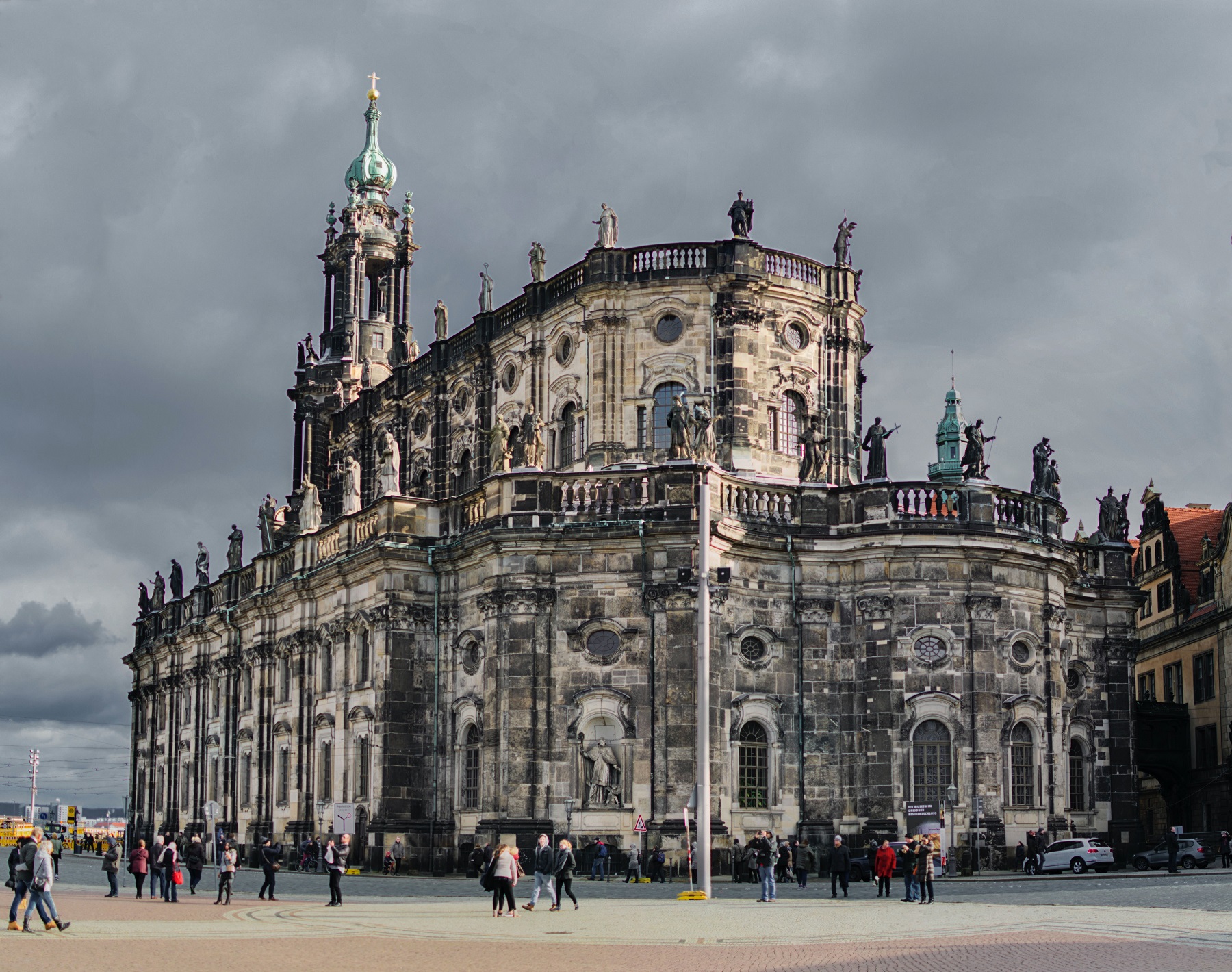
This church, also called the Cathedral of the Holy Trinity/Kathedrale Sanctissimae Trinitatis, was built in 1738-1755 in a stylistic combination of Roman and German Baroque, later known as Dresden Baroque. The church was the court’s, and it became Catholic so that Augustus could be crowned king of Catholic Poland. However, the church later became Protestant a transition. Today, the Katolische Hofkirche is Catholic, and it was elevated to the episcopal seat of the Diocese of Dresden-Meißen in 1980.
Katolische Hofkirche was designed by Gaetano Chiaveri, and as a court church it was located by the city’s residence castle. A passageway was even built, structurally connecting the church with the castle. The characteristic features of the church’s exterior are best seen from the side, where the almost free-standing high central nave is surrounded by lower side naves and with a slender tower in front of the nave. The ground floor measures 92×54 metres, and the tower is 86 meters high.
In the exterior design, there are 78 figures of saints on the church’s balustrade. They were executed by the Italian Lorenzo Mattieli together with the local artists Jakob and Paul Mayer. At the church’s entrance you can see figures of the evangelists, while many other saints adorn the rest of the church.
Inside the cathedral, you are greeted by a bright church room in the high central nave. Columns and arches frame it, and round it are two aisles and four corner chapels; Kreuzkapelle to the west, Sacraments Chapel to the south, Bennokapelle to the east and Johann Neponuk Chapel to the north.
Among the noteworthy details in the church are Balthasar Permoser’s elegant pulpit and high altar in marble and gilded bronze pieces. The altarpiece was produced by the court painter Anton Raphael Mengs, and it shows the Ascension of Christ. The painting is from 1752-1761, and it measures an impressive 10×4.5 metres. The church organ is also worth noting. Produced by Gottfried Silbermann from 1750, it was completed in 1755 as the last of Silbermann’s four organs in Dresden. Today it is the only preserved of them.
Under the Katolische Hofkirche, a crypt was built from the start to serve as the final resting place for the regents of Saxony and their families. Among those buried are August III, Friedrich August II and Georg von Sachsen. Here is also a capsule with the heart of Augustus the Strong; his remains are buried in Wawel in Krakow.
Fürstenzug is a 102-metre-long mural that, among other things, shows all Saxon rulers from 1127 to 1904. The work consists of approximately 25,000 Meissen porcelain tiles, making it the largest of its kind in the world.
Füstenzug was set up in the period 1904-1907. There had also been various paintings on the wall in the past, but none as impressive as the Fürstenzug, which was put up to weatherproof its 19th-century predecessor.
There are a total of 94 people pictured on the Fürstenzug. They are divided into 35 margraves, electors and kings and 59 others, representing scientists, artists, farmers, craftsmen and more. The earliest regent shown is Konrad the Great, who reigned 1127-1156. The latest is Georg, who was king 1902-1904.

The Residenzschloß is the historic residence of the Saxon Electors (1547-1806) and Kings (1806-1918). The castle was built in the Renaissance and stands as one of the many beautiful buildings in Dresden’s primarily Baroque centre. Through the many years as a residence, the place has played a major political and cultural role for the city and the state of Saxony.
The lower parts of the Residenzschloß date from the 13th century, while the central parts are from the construction in the New Renaissance style in the years 1548-1556. From the earliest building parts to the newest, the many centuries have meant that most styles from the Romanesque era to historicism are represented in the large building complex. The 100-metre-high tower, Hausmannsturm, is decorated with a baroque hood, for example. The tower in its current style was completed in the years 1674-1676, and it was Dresden’s tallest building. In the tower, there is a viewing platform at a height of approximately 39 metres, and from here there is a fine view of the city centre.
Over the past decades, the castle has undergone a restoration, and it is now set up as an elegant museum complex with several different exhibitions. The most well-known is probably the Grünes Gewölbe treasury, which exhibits one of the city’s and the country’s finest collections, including the sumptuous jewelery of the princes.
The coin cabinet/Münzkabinett consists of a large collection of coins, medals, banknotes and other effects from antiquity to the present. The Kobberstikkabinett/Kupferstich-Kabinett is an exhibition of various graphic productions, photographs and so on, while the Rustkammeret/Rüstkammer includes distinguished historical collections of weapons from the 15th-18th centuries. Part of the Rüstkammer is the Türckische Cammer, which exhibits the collection’s effects from the defunct Ottoman Empire.
A visit to one or more museums gives an insight into fine collections, and along the way you can enjoy the setting. The museums are partly arranged in Renaissance and Baroque halls, which are attractions in themselves.
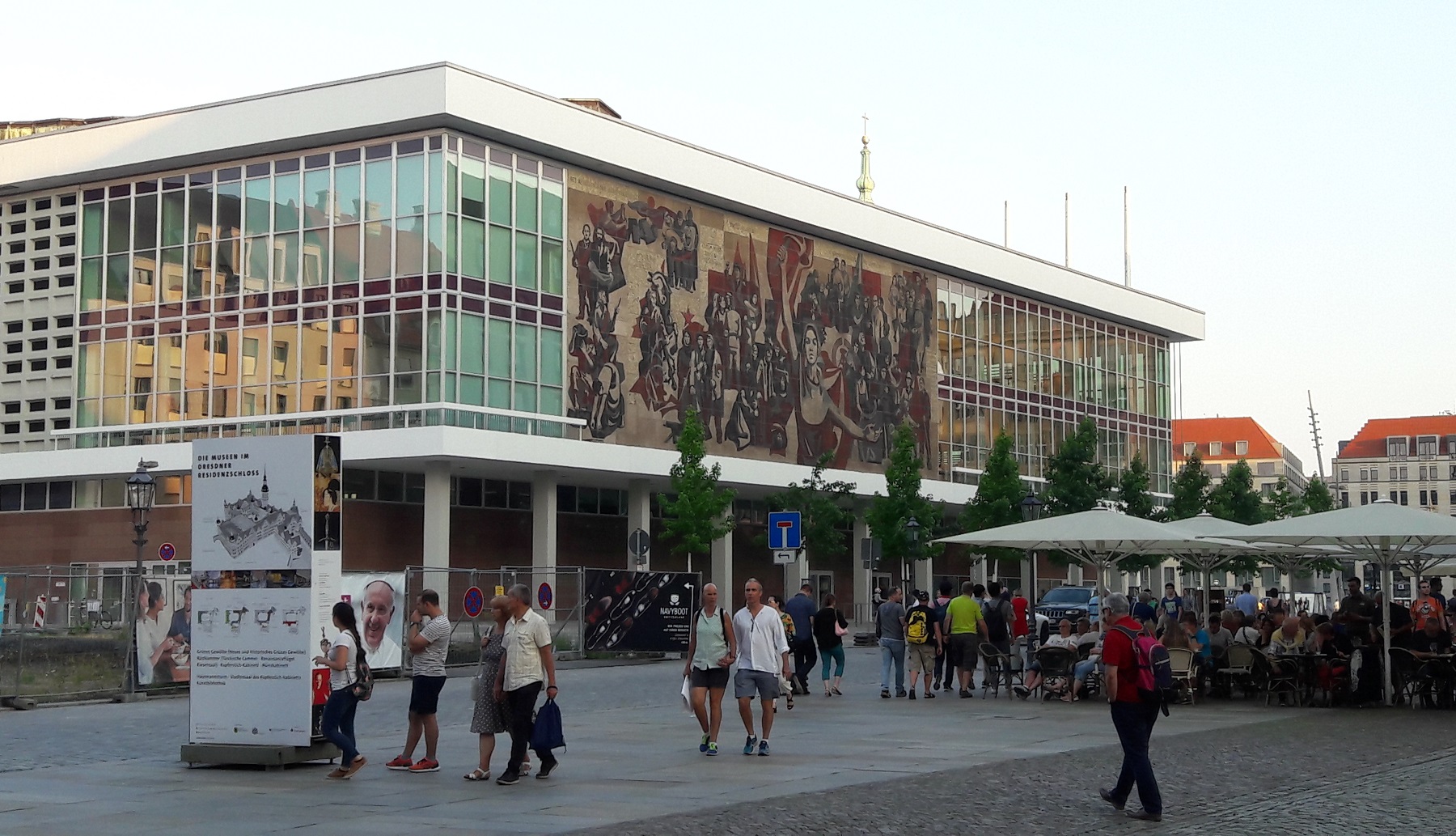
On the north side of the Altmarkt square is the Kulturpalast from 1969, where the city’s symphony orchestra plays. Kulturpalast is a stylistically period-typical building from GDR-era modernism and stands as a fine example of architecture from this time.
On the west side of the building you can see the artwork Den Røde Fanes Vej/Der Weg der roten Fahne, which depicts symbols of and representatives from the worker and peasant state of the GDR. The work was created by a group of artists led by Gerhard Bondzin.
The street Prager Straße is a street that was laid out in the Seevorstadt district in the middle of the 19th century to connect the city’s historic core with the railway a little to the south. The street was laid out in 1851-1853, and the area around it was rapidly developed over the following decades.
With the bombing of Dresden in 1945, the entire district around Prager Straße was razed to the ground, so that literally not a single building remained after the clearing of the many rubbles that remained.
The reconstruction of the destroyed Seevorstadt was started with an architectural competition in 1962. The result was a reconstruction that stands to this day as a fine example of the grandiose and modern urban planning of the GDR era.
The central part of Prager Straße is a pedestrian area with large block buildings on both sides. The largest is the residential block Prager Zeile on the east side. This block was built 1965-1967 as the second longest block of flats in Germany, surpassed only by a building in the city of Leipzig. To the west, among other things, large restaurants and the hotel blocks Bastei, Königstein and Lilienstein were built, which were named after rocks in the area southeast of Dresden.
Just north of Prager Zeile is the rotunda Rundkino, which was built as a cinema in the years 1969-1972. The cinema stands architecturally in the post-war modernism of the GDR era.
In the southern part of Prager Straße towards Wiener Platz and the railway station are a number of modern buildings, including hotels and shopping centres. The same applies just north of the central GDR buildings.
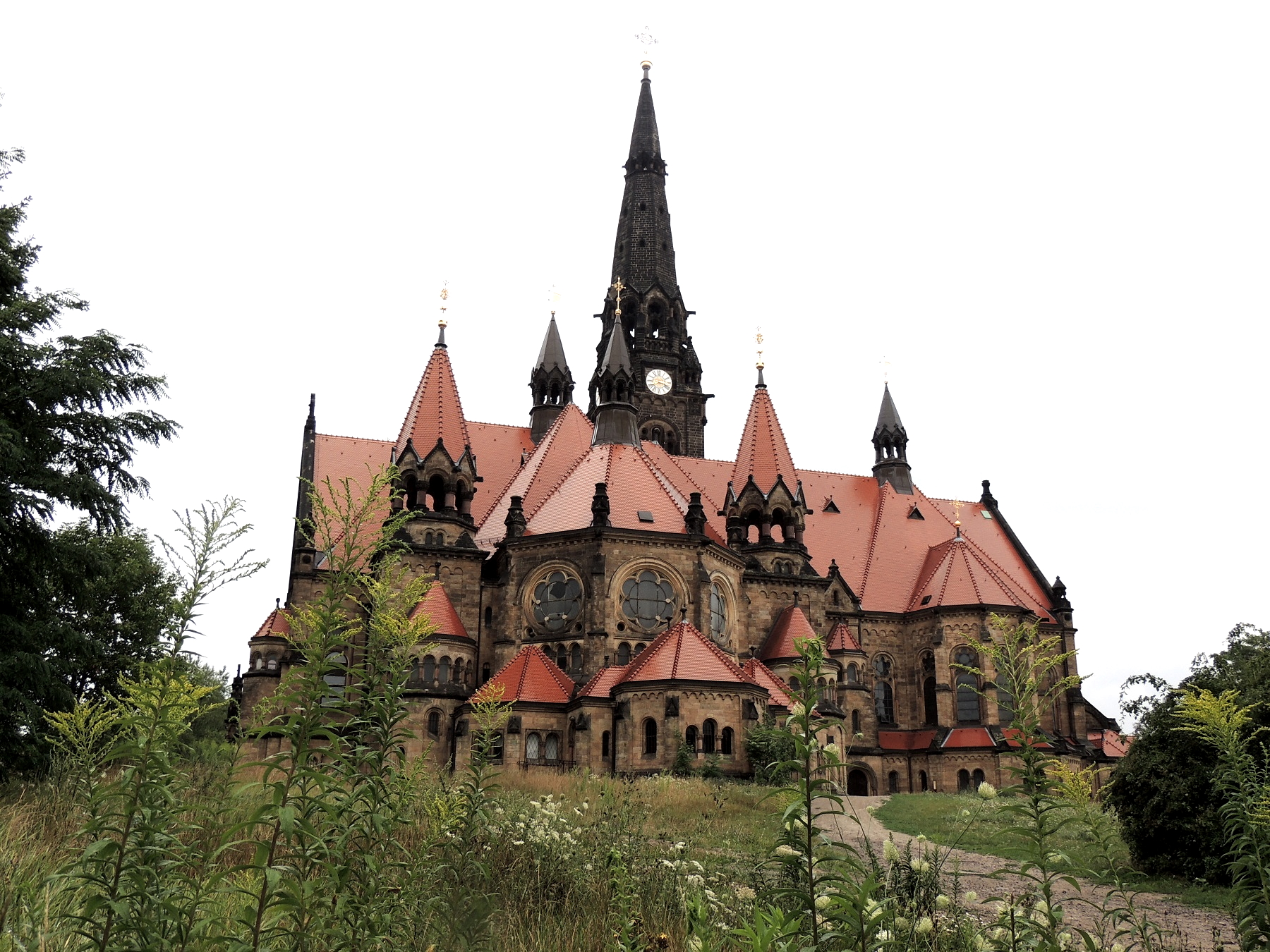
The church Garnisonskirche St. Martin was built as a military church, and it is also located between various barracks buildings in this part of Dresden. At the end of the 19th century, around 10,000 soldiers lived in the area, and the city’s other churches had become too small for the many new churchgoers.
In order to accommodate both Protestants and Catholics, the Garnisonskirche was built as a simultaneous church for both congregations. It was inaugurated in 1900 after five years of construction, and it belongs to the city’s most impressive buildings from that time. The church tower measures 90 meters in height and the bells are said to have been forged from French cannonballs.
From 1945 the church was used, among other things, as a magazine, and in 2004 the city’s puppet theater collection was arranged here as a museum. However, the museum only occupies a part of the church’s large and beautiful space.
The dairy milk Pfund’s Molkerei is known as perhaps the world’s most beautiful milk bar. The almost sumptuous interior with the exciting tile paintings is a must for visitors to the city. During a visit, the large selection of dairy products such as cheese can of course be purchased, and the milk bar is also a café where you can enjoy the fine surroundings in peace and quiet.
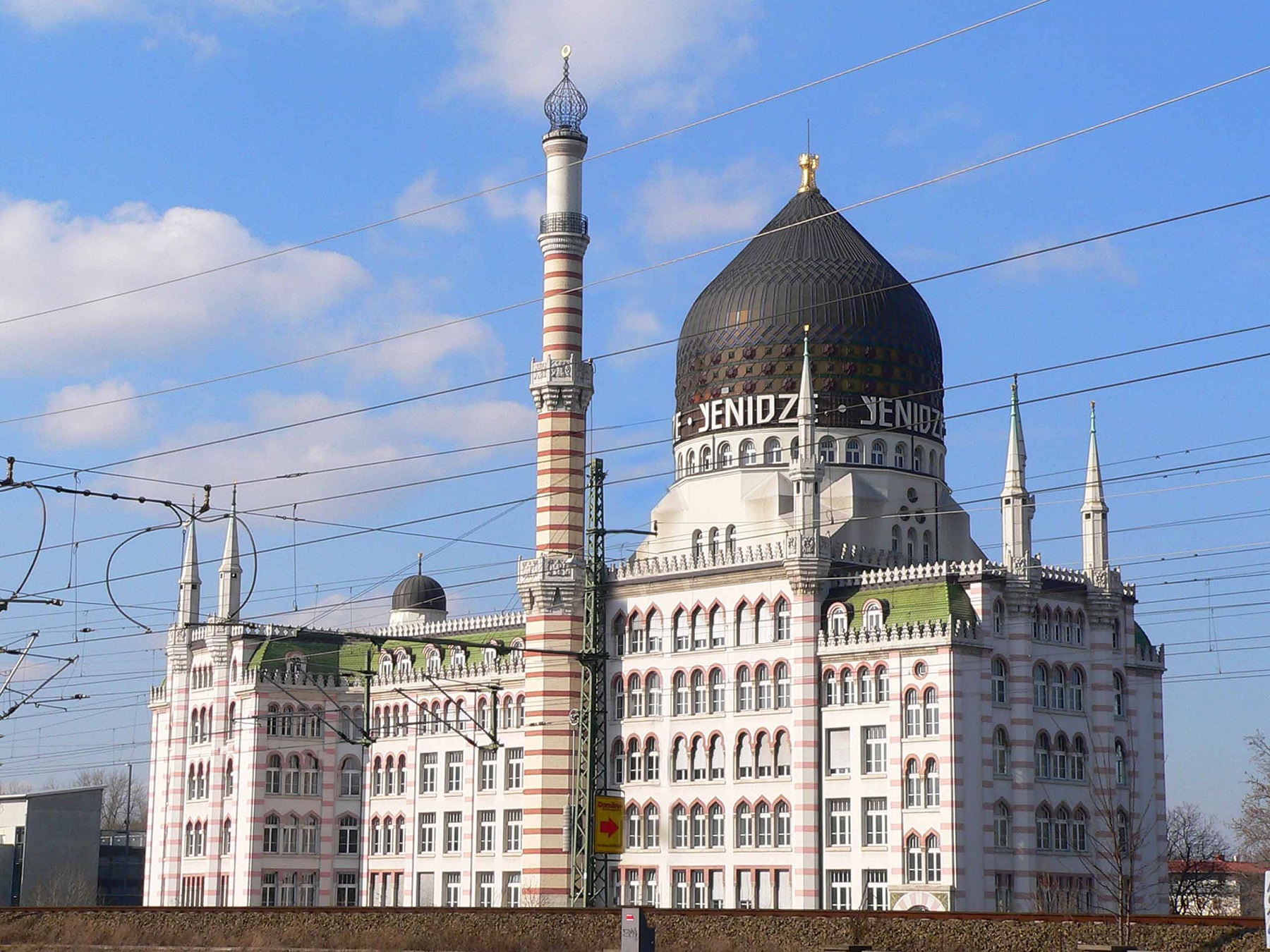
Yenidze is the name of a distinctive former tobacco factory that was architecturally almost built as a colossal mosque in Moorish-oriental style in the period 1907-1909. Today, the building is furnished with offices, and it is also used for various events.
The builder was the contractor Hugo Zietz, who imported tobacco from the Greek town of Yenidze, today called Genisea. It was the architect Martin Hammitzsch who designed the beautiful building, which was actively used in the marketing of the factory’s tobacco products.
The street Königstraße runs from Augustus the Strong’s summer palace, Japanisches Palais, to the large square Albertplatz. Königstraße was laid out in 1731 as the central axis of the new district of the royal city, Neue Königstadt, which was to be built after the fire in Dresden in 1685. Neue Königstadt gradually became just Neustadt, as it is known today.
The townhouses in the area give a very fine impression of baroque Dresden, and most of the preserved buildings from the city’s older history are gathered here, as they were some of the only ones from the baroque to survive the Allied bombardment in 1945. If you are curious, you can also take a look into some of the old inner courtyards.
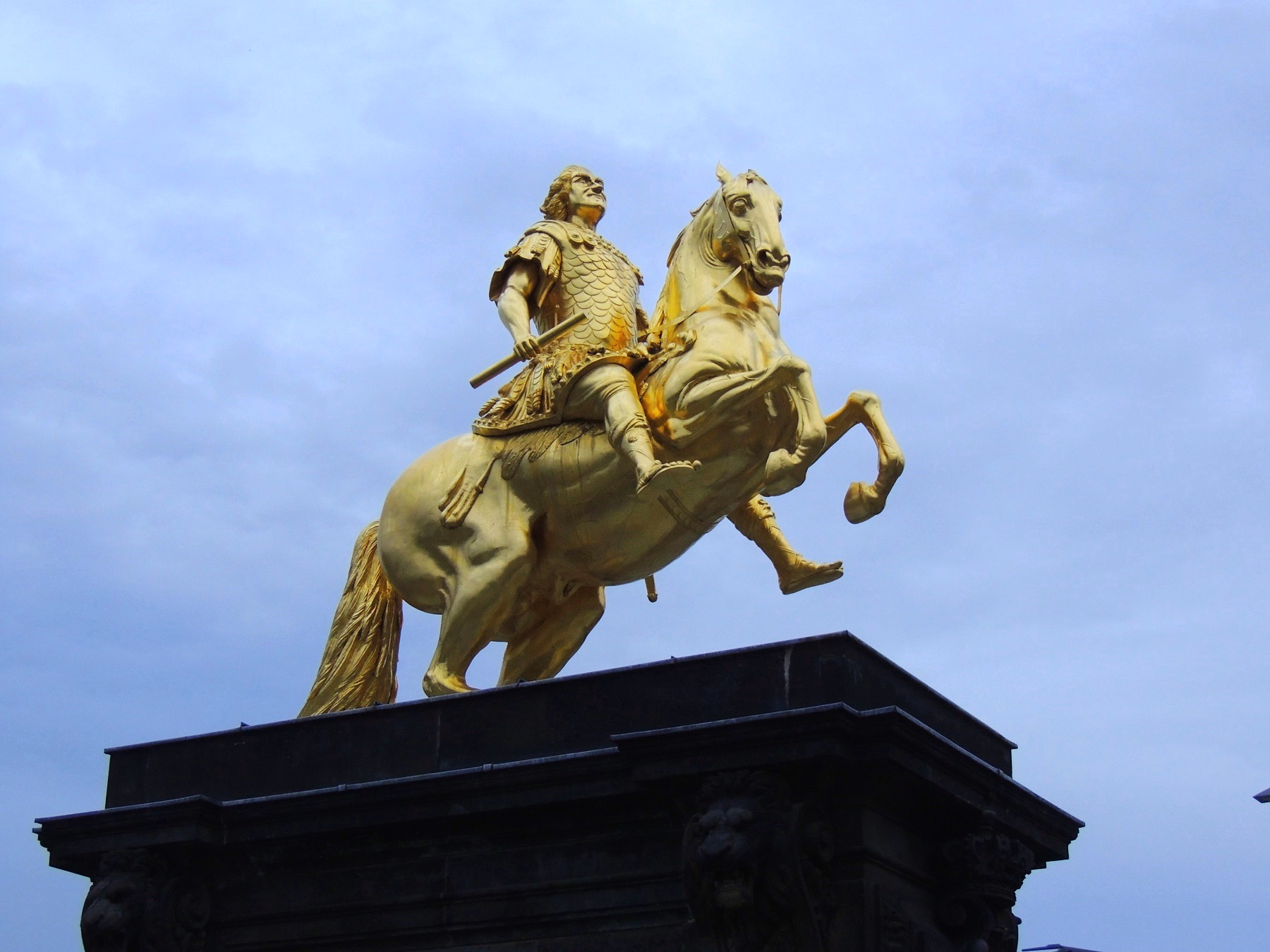
August the Strong laid out a part of Neustadt with the magnificent Hauptstraße, and at the southern start of it stands the equestrian statue Goldener Reiter, which is a memorial to August the Strong. The monument was erected in 1736, which was the time when the district and thereby a large expansion of Dresden was established and built upon. Today, Den Gyldne Ridder is one of the city’s landmarks.
The Altmarkt is Dresden’s largest and oldest square, and it is Dresden’s historic square for the city’s commerce. There are still ongoing market activities here, and here you can, among other things, experience Germany’s oldest Christmas market, which dates back around five centuries.
Today, Altmarkt is also a traffic hub, where pedestrians cross from the old city center to the area around the city’s main railway station, and the city’s trams run in Wilsdruffer Straße.
On the east and west sides of Altmarkt you can today see large and quite impressive buildings from the 1950s. They were built with inspiration from Dresden’s historically famous Baroque. The most impressive of these buildings is Haus Altmarkt (Altmarkt 4–6/Wilsdruffer Straße 15–21), which stands in socialist classicism mixed with features from Dresden’s architectural history. The house was built in the years 1953-1956.
On the northern side of the Altmarkt is the street Wilsdruffer Straße, which was laid out as the GDR’s parade street in Dresden. It was made 61 meters wide and used for special events that were celebrated during the time of East Germany. One of the major recurring events was the celebration of May Day, which was a major event throughout the Eastern Bloc.
Neumarkt is one of the most important squares in Dresden’s old town, and this particular area was one of the earliest to be built on in what eventually developed into present-day Dresden.
Neumarkt was almost completely destroyed during the British bombing raids in 1945, and in the GDR era a reconstruction began with part reconstructions and part modern buildings. Despite a great deal of effort, however, a significant part of Neumarkt remained undeveloped.
After the reunification of East and West Germany, it was decided to rebuild the Neumarkt in its appearance before the Second World War bombings. The Frauenkirche is the finest result of the reconstruction, which is still taking place.
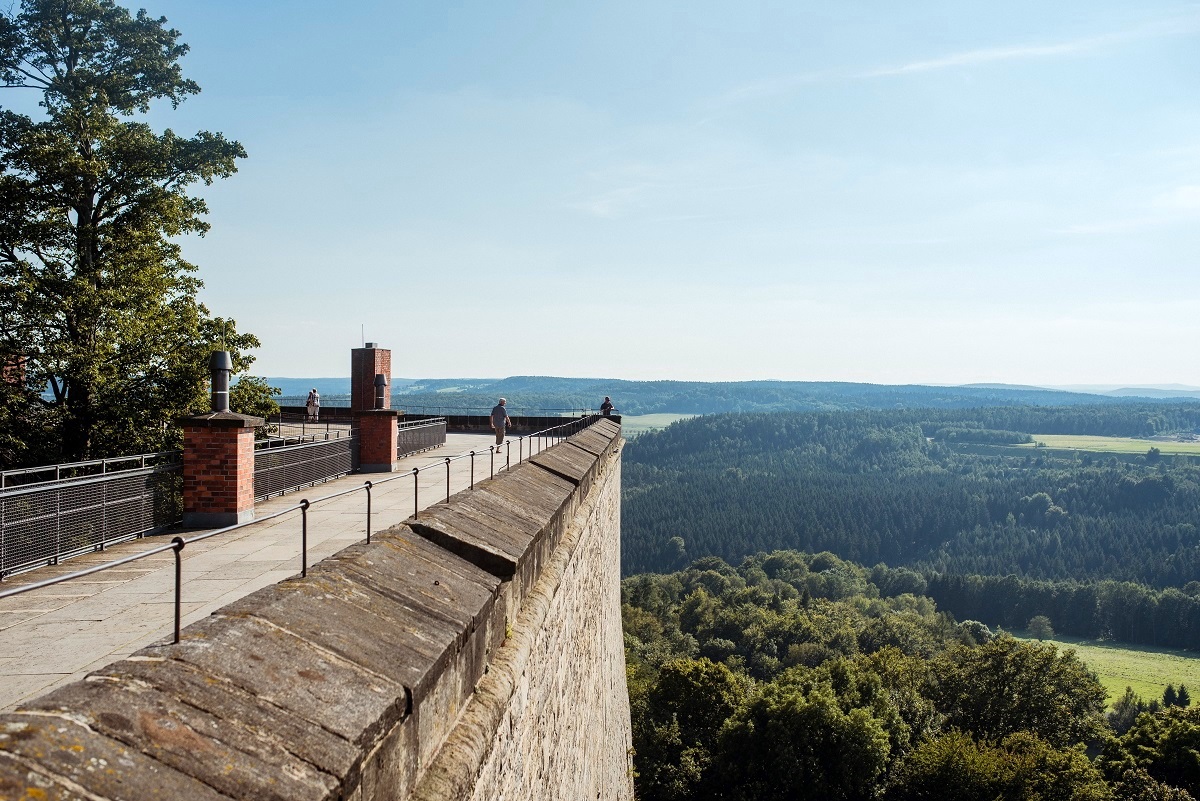
The Königstein fortress is located on top of one of the Sächsische Schweiz national park’s mountains, and from its construction in 1589 it was considered impregnable. However, there are mentions of fortifications on the site as early as the 13th century, so the current Festung Königstein is not the original castle on the mountaintop.
Königstein is beautifully situated as one of Europe’s largest mountain castles. It was originally built by the Bohemian Václav I, who wanted to be able to defend the border between the Kingdom of Bohemia and the church-ruled Meißen. From Königstein there was a view and access to large parts of the strategically important area around the course of the Elbe.
The glory value also made the fortress a residence for many of Europe’s royals over the centuries. And the impregnable location meant that the Saxon monarchs went here with their treasures in troubled times.
Later and until 1922, Königstein functioned partly as a prison. Among the most prominent prisoners of the time were Johann Friedrich Böttger, who is considered the inventor of European porcelain, and August Bebel, who founded the German Social Democratic Party.
Today there is good access to Festung Königstein, which is like a large museum. There are tours to the fortress from the town and the car parks at the foot of the ridge on which the castle complex sits.
Sächsische Schweiz is a breathtaking national park southeast of Dresden. Here you can experience a very varied nature with, among other things, forests, river valleys and steep cliffs, which offer the opportunity for unique panoramic views.
In the countryside there are also various places of cultural and historical interest, which you can spice up a trip here with. The most well-known places are mentioned here, but there are many other opportunities for good visits and trips in the area that lies along the course of the Elbe.
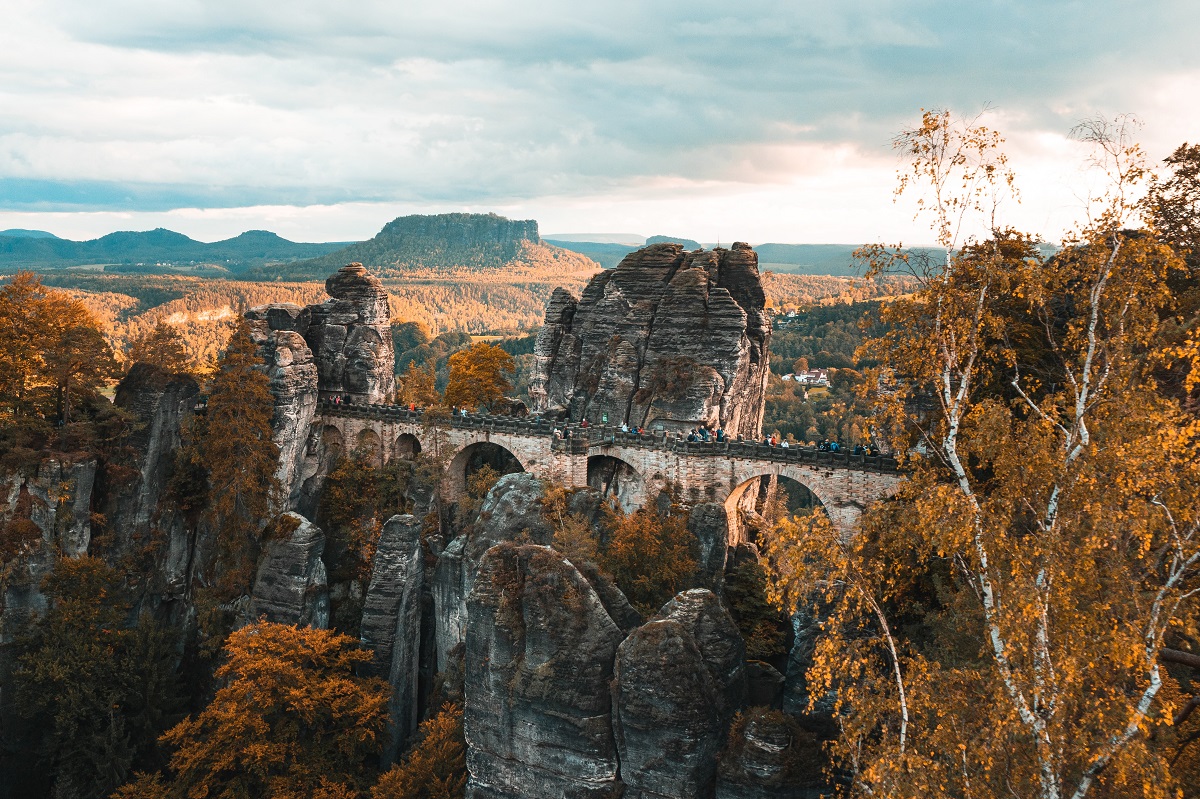
Near the town of Rathen is the Bastei rock, which rises 190 meters above the winding course of the Elbe to a height of 305 meters above sea level. You can view the beautiful sandstone formations at Bastei from several angles, and you can also walk over a bridge, the Basteibrücke, which is practically built from cliff top to cliff top. The view from here is unforgettable, as from the cliff you can see the entire area’s river valley of the Elbe and the Table Mountains around the area.
South-east of Dresden is the elegant pleasure castle complex Pillnitz. The location is beautiful directly down to the Elbe, and therefore there are also many who come to the place on an excursion boat.
Of the castle’s various owners, the most important is August the Strong, who took over the castle in 1694. During his time, he had the existing facility expanded and remodeled into an impressive baroque facility inspired by the popular Chinese fashion of the time.
The castle’s main building, the Bergpalais, was built in 1722-1723, while the Wasserpalais on the banks of the Elbe dates from 1720-1721.
Pillnitz’s big attraction is of course the beautiful grounds of the castle and baroque garden, and one of the highlights is the over 200-year-old and over eight-metre-high Camellia plant, the so-called Pillnitzer Camellia, which is believed to have been brought from Japan to Europe in 1776.
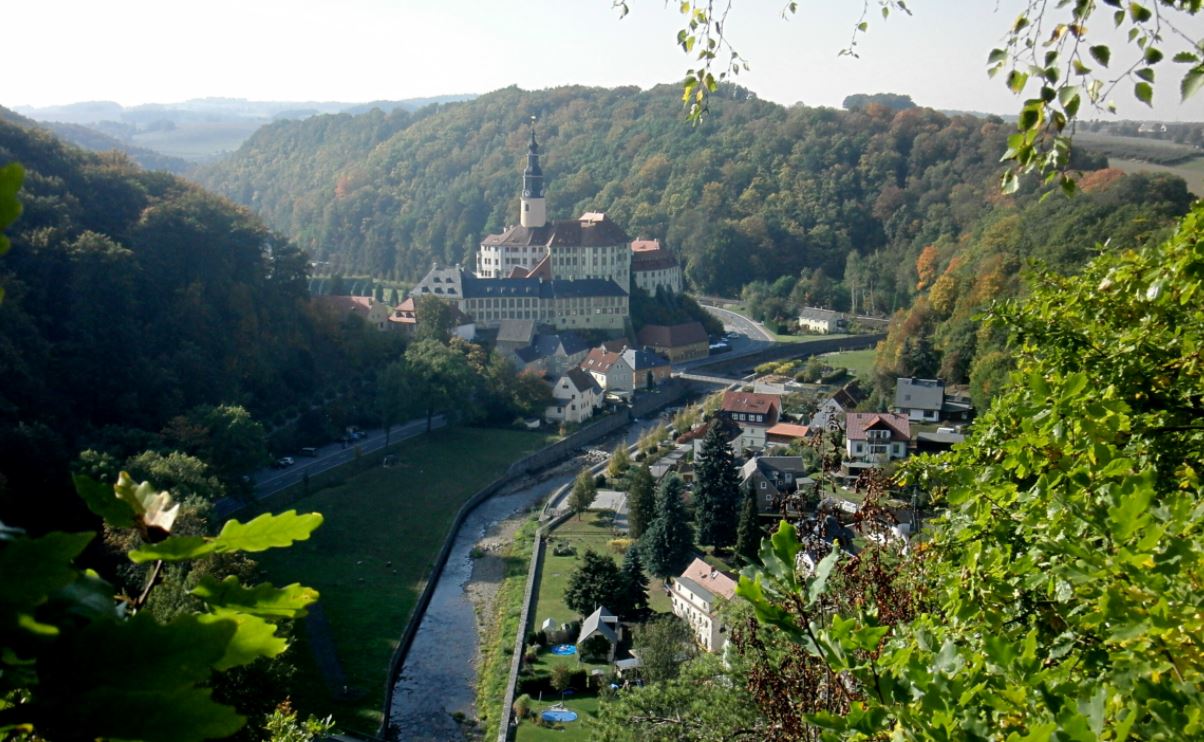
This is one of the beautiful castles southeast of Dresden. It was built of burgraves by Dohna, and the great castle was extended over the centuries. You can therefore see Gothic architecture and parts from the Renaissance, Baroque and Classicism. The baroque castle church is one of the highlights and you can also enjoy a walk in the formal castle park, which is beautifully laid out in the hilly terrain.
Webergasse 1-29
altmarkt-galerie-dresden.de
Peschelstrasse
elbe-park-dresden.de
Prager Straße 12
karstadt.de
Wiener Platz
kugelhaus-dresden.com
Metzer Straße 1
markthalle-dresden.de
Reicker Straße 60
odc-center.de
Loschwitzer Straße 52a
schillergalerie.de
Prager Straße, Altmarkt, Wilsdruffer Straße, Königstraße, Hauptstraße
Dresdner Verkehrsmuseum
Augustusstraße 1
verkehrsmuseum.de
Elbamare
Wölfnitzer Ring 65
elbamare.de
Dresdner Straßenbahnmuseum
Trachenbergerstraße
dvbag.de
Zoo Dresden
Großer Garten
zoo-dresden.de
Dresdner Parkeisenbahn
Hauptallee 5
parkeisenbahn-dresden.de
Elbe’s nutritious lands have attracted settlers early, and in the 500s Germanic tribes came from the east, while Bohemian slaves came to the area from the south and founded the city of Drezdany.
In the 9th century, the Germanic armies under King Heinrich I conquered the Slavic lands between the rivers Saale and the Elbe, and their center of power became the new castle in Meißen northwest of Dresden.
Traders and craftsmen settled the territories and established trade routes, and in the 12th century the leaders of the Meissen decided to erect a castle at the Elbe to protect and control the area and crossing of the river at the village of Drezdany.
The castle at the Elbe grew into small settlements, and officially these settlements became the city of Dresden in 1206. The original Dresden was on the left side of the Elbe in today’s city center. Development was slow in the city, and neither the city nor its economy flourished.
Around 1500, there were almost 6,000 inhabitants in Dresden and the surrounding villages, among others the town of Altendresden, which had been founded on the opposite side of the Elbe.
In 1485, the territory of the Meissen was divided, and the Albertan side of the Welsh prince’s family decided to settle in Dresden as their new residence.
In 1491 Dresden fell victim to a fire that destroyed much of it, yet the city under Prince Georg was quickly rebuilt.
Under Prince Georg, the Reformation came to the German territories, and Dresden, because of the princely opposition, became a central city that was opposed to Martin Luther’s new ideas. However, Prince Georg’s successor quickly completed the Reformation in Dresden.
Dresden’s development happened very quickly in the following years. The economic activity was strongly increasing, which was not least due to the needs and wishes of the princely family. The population also increased, now that Dresden had become a real residential town.
In 1547, Dresden became the capital of Saxony, the most important Protestant region and after the Habsburg Empire the most influential German state.
Dresden experienced rapid development. The old castle was rebuilt into a beautiful palace complex, and the medieval town was modernized and fortified with fortifications. The city’s cultural life was actively strengthened. Up through the 16th century, the population tripled.
From 1620 Saxony became involved in the Thirty Years War. Dresden was not occupied, but the war stalled the city’s expansion, and plague and famine plagued the area. The ceasefire only lasted just after the end of the war, after which Dresden quickly regained the greatness and power of the past. The culture thrived, and in 1670 the beginning of industrialization was started in the district of Friedrichstadt.
With Prince August the Strong’s coronation to the Polish king in 1697, Dresden became a capital of European scale. Its Baroque buildings were erected and in the first half of the 18th century the population again tripled to now 63,000.
In August 1756, a setback to the city came. Prussian troops occupied Dresden, and the fighting during the Seven Years’ War destroyed much of the city and stopped the development entirely. The rebuilding of the city was slow, and it took about 60 years for the population to reach its former level.
Under Napoleon, France overcame Saxony, which became the country’s ally. Napoleon stayed in the city several times, and one of his last victories was in 1813 outside the city walls of Dresden.
After the Napoleonic era, industrialization came to Dresden. Among other things, the first German intercity railway line was built in 1839; it connected the cities of Dresden and Leipzig. In the decades that followed, the city grew rapidly and Dresden was the fourth largest city in the German Empire.
World War I resulted, among other things, in the abdication of King Friedrich August III, and the Free State of Saxony was formed as a replacement for the former kingdom. By the end of the 19th century Dresden had become a large garrison town, but the garrison was only in limited activity between the two world wars of the 20th century.
However, the city had been continuously developed as a production city and as a communication center. The military industry had also been built up in and around Dresden, considered a place to be defended.
During World War II, many refugees came to the city in connection with Germany’s rising defeat against and in 1945. There were about 600,000 refugees in Dresden, who with them had over a million inhabitants.
On 13-15 February 1945 over 1,000 British and US bombers attacked Dresden. In total, they threw 2,431 tons of high explosive bombs and 1,475 tons of fire bombs. Germany’s defeat a few months later was almost already a reality at the time of the bombings that killed thousands of civilians, which is why the attacks remain controversial. The result of the bombs was that almost all of Dresden’s center was totally destroyed three months before the arrival of the Red Army.
The labor and peasant state took over in the East German area, and with Dresden they were given a city that was in the process of complete reconstruction. The city rose again, and it happened surprisingly quickly. With Soviet assistance, the GDR initiated both a reconstruction of the Baroque Dresden and a new building of a modern East German metropolis.
The reconstruction took many years, but most of the many destroyed buildings were rebuilt one by one in the GDR, which at the same time developed Dresden in socialist modernism, characterized by large-scale construction and the ambition of a new society that was far from the past. noble and royal capital. In the same year, Dresden developed into a major industrial center in the GDR.
In today’s Germany, Dresden is the capital of the federal state of Saxony, and the city’s beautiful baroque splendor buildings are being rebuilt with new buildings after the German reunification; not least the famous Frauenkirche. Around Frauenkirche, the redevelopment of the area at Neumarkt Square continues.
Today, Dresden is a city whose center is listed on UNESCO’s World Heritage List. Visitors flock to the old city, its culture and its museums again. At the same time, Dresden has also experienced new industries such as Volkswagen’s famous transparent assembly plant.
 Dresden, Germany[/caption]
Dresden, Germany[/caption]
Overview of Dresden
Dresden is one of the most beautiful cities in Germany. Zwinger, Katolische Hofkirche, Semperoper and Frauenkirche are some of the famous building from the magnificent baroque era, which the city is so famous for. However, Dresden has much more to offer as well, such as Altmarkt and Prager Straße, both originating from the GDR.
Throughout time, the Saxon princes have built Dresden as a true world city in beautiful Baroque, and fine culture has always flourished among the beautiful buildings. As a visitor, you will enjoy this when you visit the grand museums, see the fine architecture or just walk the city streets. The scenery along the River Elbe is worth seeing on the way.
Dresden was almost totally wiped out by a Allied bombing 13-15 February 1945, but since then the city has resurrected to former glory. It happened with almost the same ambition as in the original constructions. The history of the bombing and reconstruction can be seen in museums, and the church of Frauenkirche is the landmark building of this part of Dresden’s history.
About the Whitehorse travel guide
Contents: Tours in the city + tours in the surrounding area
Published: Released soon
Author: Stig Albeck
Publisher: Vamados.com
Language: English
About the travel guide
The Whitehorse travel guide gives you an overview of the sights and activities of the Canadian city. Read about top sights and other sights, and get a tour guide with tour suggestions and detailed descriptions of all the city’s most important churches, monuments, mansions, museums, etc.
Whitehorse is waiting for you, and at vamados.com you can also find cheap flights and great deals on hotels for your trip. You just select your travel dates and then you get flight and accommodation suggestions in and around the city.
Read more about Whitehorse and Canada
Canada Travel Guide: https://vamados.com/canada
City tourism: https://visitwhite-horse.ca
Main Page: https://www.vamados.com/
Buy the travel guide
Click the “Add to Cart” button to purchase the travel guide. After that you will come to the payment, where you enter the purchase and payment information. Upon payment of the travel guide, you will immediately receive a receipt with a link to download your purchase. You can download the travel guide immediately or use the download link in the email later.
Use the travel guide
When you buy the travel guide to Whitehorse you get the book online so you can have it on your phone, tablet or computer – and of course you can choose to print it. Use the maps and tour suggestions and you will have a good and content-rich journey.


On the north side of the Altmarkt square is the Kulturpalast from 1969, where the city’s symphony orchestra plays. Kulturpalast is a stylistically period-typical building from GDR-era modernism and stands as a fine example of architecture from this time.
On the west side of the building you can see the artwork Den Røde Fanes Vej/Der Weg der roten Fahne, which depicts symbols of and representatives from the worker and peasant state of the GDR. The work was created by a group of artists led by Gerhard Bondzin.
The street Prager Straße is a street that was laid out in the Seevorstadt district in the middle of the 19th century to connect the city’s historic core with the railway a little to the south. The street was laid out in 1851-1853, and the area around it was rapidly developed over the following decades.
With the bombing of Dresden in 1945, the entire district around Prager Straße was razed to the ground, so that literally not a single building remained after the clearing of the many rubbles that remained.
The reconstruction of the destroyed Seevorstadt was started with an architectural competition in 1962. The result was a reconstruction that stands to this day as a fine example of the grandiose and modern urban planning of the GDR era.
The central part of Prager Straße is a pedestrian area with large block buildings on both sides. The largest is the residential block Prager Zeile on the east side. This block was built 1965-1967 as the second longest block of flats in Germany, surpassed only by a building in the city of Leipzig. To the west, among other things, large restaurants and the hotel blocks Bastei, Königstein and Lilienstein were built, which were named after rocks in the area southeast of Dresden.
Just north of Prager Zeile is the rotunda Rundkino, which was built as a cinema in the years 1969-1972. The cinema stands architecturally in the post-war modernism of the GDR era.
In the southern part of Prager Straße towards Wiener Platz and the railway station are a number of modern buildings, including hotels and shopping centres. The same applies just north of the central GDR buildings.

The church Garnisonskirche St. Martin was built as a military church, and it is also located between various barracks buildings in this part of Dresden. At the end of the 19th century, around 10,000 soldiers lived in the area, and the city’s other churches had become too small for the many new churchgoers.
In order to accommodate both Protestants and Catholics, the Garnisonskirche was built as a simultaneous church for both congregations. It was inaugurated in 1900 after five years of construction, and it belongs to the city’s most impressive buildings from that time. The church tower measures 90 meters in height and the bells are said to have been forged from French cannonballs.
From 1945 the church was used, among other things, as a magazine, and in 2004 the city’s puppet theater collection was arranged here as a museum. However, the museum only occupies a part of the church’s large and beautiful space.
The dairy milk Pfund’s Molkerei is known as perhaps the world’s most beautiful milk bar. The almost sumptuous interior with the exciting tile paintings is a must for visitors to the city. During a visit, the large selection of dairy products such as cheese can of course be purchased, and the milk bar is also a café where you can enjoy the fine surroundings in peace and quiet.

Yenidze is the name of a distinctive former tobacco factory that was architecturally almost built as a colossal mosque in Moorish-oriental style in the period 1907-1909. Today, the building is furnished with offices, and it is also used for various events.
The builder was the contractor Hugo Zietz, who imported tobacco from the Greek town of Yenidze, today called Genisea. It was the architect Martin Hammitzsch who designed the beautiful building, which was actively used in the marketing of the factory’s tobacco products.
The street Königstraße runs from Augustus the Strong’s summer palace, Japanisches Palais, to the large square Albertplatz. Königstraße was laid out in 1731 as the central axis of the new district of the royal city, Neue Königstadt, which was to be built after the fire in Dresden in 1685. Neue Königstadt gradually became just Neustadt, as it is known today.
The townhouses in the area give a very fine impression of baroque Dresden, and most of the preserved buildings from the city’s older history are gathered here, as they were some of the only ones from the baroque to survive the Allied bombardment in 1945. If you are curious, you can also take a look into some of the old inner courtyards.

August the Strong laid out a part of Neustadt with the magnificent Hauptstraße, and at the southern start of it stands the equestrian statue Goldener Reiter, which is a memorial to August the Strong. The monument was erected in 1736, which was the time when the district and thereby a large expansion of Dresden was established and built upon. Today, Den Gyldne Ridder is one of the city’s landmarks.
The Altmarkt is Dresden’s largest and oldest square, and it is Dresden’s historic square for the city’s commerce. There are still ongoing market activities here, and here you can, among other things, experience Germany’s oldest Christmas market, which dates back around five centuries.
Today, Altmarkt is also a traffic hub, where pedestrians cross from the old city center to the area around the city’s main railway station, and the city’s trams run in Wilsdruffer Straße.
On the east and west sides of Altmarkt you can today see large and quite impressive buildings from the 1950s. They were built with inspiration from Dresden’s historically famous Baroque. The most impressive of these buildings is Haus Altmarkt (Altmarkt 4–6/Wilsdruffer Straße 15–21), which stands in socialist classicism mixed with features from Dresden’s architectural history. The house was built in the years 1953-1956.
On the northern side of the Altmarkt is the street Wilsdruffer Straße, which was laid out as the GDR’s parade street in Dresden. It was made 61 meters wide and used for special events that were celebrated during the time of East Germany. One of the major recurring events was the celebration of May Day, which was a major event throughout the Eastern Bloc.
Neumarkt is one of the most important squares in Dresden’s old town, and this particular area was one of the earliest to be built on in what eventually developed into present-day Dresden.
Neumarkt was almost completely destroyed during the British bombing raids in 1945, and in the GDR era a reconstruction began with part reconstructions and part modern buildings. Despite a great deal of effort, however, a significant part of Neumarkt remained undeveloped.
After the reunification of East and West Germany, it was decided to rebuild the Neumarkt in its appearance before the Second World War bombings. The Frauenkirche is the finest result of the reconstruction, which is still taking place.
Similar to Dresden Travel Guide
